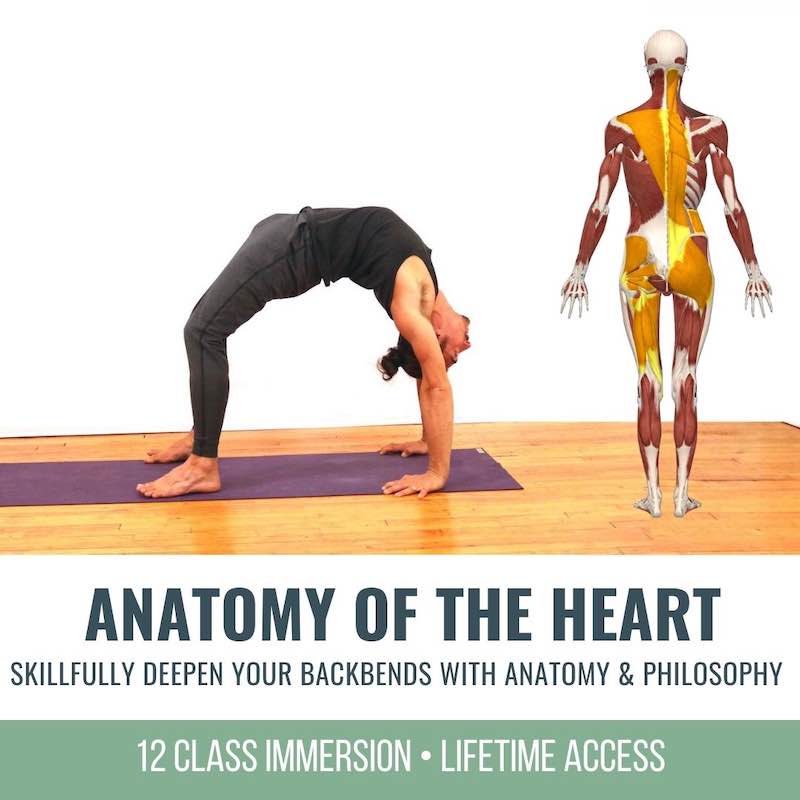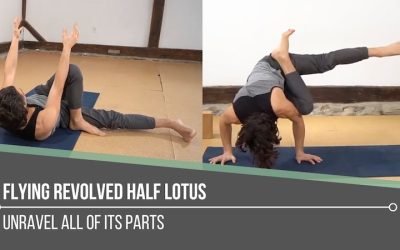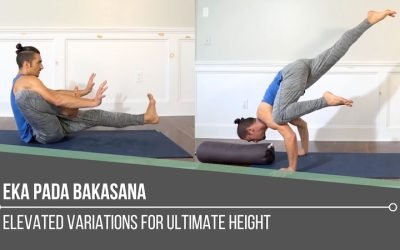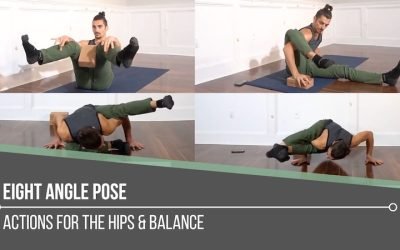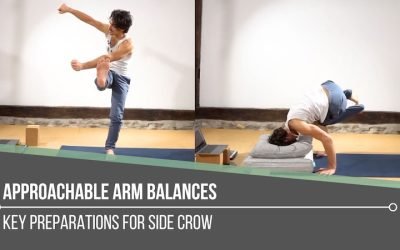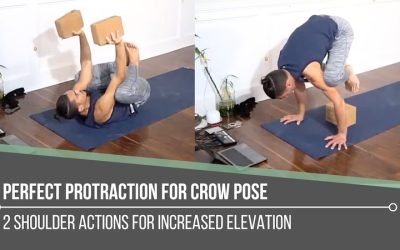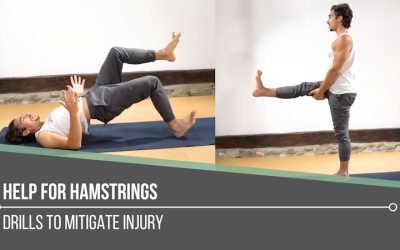Flying Revolved Half LotusARM BALANCEFLYING REVOLVED HALF LOTUS Some postures don’t arrive through imitation; they arrive through investigation. Flying Revolved Half Lotus is one of those shapes. It borrows familiar ingredients like Side Crow mechanics, hip opening,...
Eka Pada Urdhva Dhanurasana
Eka Pada Urdhva Dhanurasana
Where to Induce Strength
back line strength
EKA PADA URDHVA DHANURASANA
There’s no doubt that back-line strength (more specifically, strength from the gluteus maximus, hamstrings, and erector spinae) is a requirement to elevate your hips off of your yoga mat in Urdhva Dhanurasana. Moreover, when the element of the lifted leg in Eka Pada Urdhva Dhanurasana is added, the awareness of where to distribute your strength becomes heightened—you need to consider the strength to elevate your hips, and there’s a requirement to induce strength from the quadriceps and hip flexors in the lifted leg. The demand from the back line increases because you are relying on sustaining the elevation from one side of your body. In today’s video, you’ll see how Matt and his wife Rebecca Rasmussen (@dancinbecca) demonstrate exactly where and how to maximize your body’s ability to cultivate strength for this masterful posture.
ANATOMY OF THE HEART
JUNE 2022 Immersion
- Technique to expand and deepen your backbends
- Foundations and preparatory postures to set you up for success
- Anatomy education to prime the nervous system
- Themes to cultivate the appropriate mindset for heart opening
- 12 Classes: 6 focused on anatomy, 6 themed for the heart
- Unlock a wide range of postures including: Bow Pose, Camel, Full Wheel, King Dancer, King Cobra, King Pigeon, and more
- Lifetime unlimited access to all
- Attend livestream OR practice the replays any time that’s convenient for you
$168.00 $148.00
INSIDE THE ANATOMY
In the top leg, the hip flexor muscles involved in pulling your leg towards your chest include the rectus femoris, sartorius, iliacus, psoas major, pectineus, and TFL. It’s important to understand the relationship between the strength of these muscles and how they oppose the tension of the glutes and hamstrings in the same leg. This tension will reveal itself even more when you attempt to straighten your leg, which also activates the quadriceps. Along with the weight of gravity, the tension will attempt to pull your leg away from your chest. Matt advises you to prioritize strengthening your hip flexors to draw the leg closer to your chest, rather than attempting to straighten your leg and allowing it to drift away. Opting to prioritize your hip flexors here simply means that you are stepping into the opportunity to increase strength rather than chasing the aesthetic.
WATCH THE VIDEO
EKA PADA URDHVA DHANURASANA: WHERE TO INDUCE STRENGTH
BRIDGE POSE AS YOUR BASE
As always, Matt’s Chromatic approach helps to pattern and prepare your body for each progression. In Bridge Pose, you’ll see the importance of generating strength from your feet: In order to light up the power in your glutes, you press down through your inner heels and the “three points of your feet” (big toe, pinky toe, and heel). With your glutes, hamstrings, and adductor magnus activated, you’ll have enough strength to lift your hips up. Another of Matt’s tips is to feel as though you are pushing your feet away from you on the diagonal. This will help to activate your quadriceps, which translates to even more hip height. Once you’ve explored here, you can layer on the lifted leg in Bridge Pose. This variation allows you to practice taking your top leg closer to your chest in a more controlled position.
200 HOUR ONLINE TEACHER TRAINING
GET CERTIFIED & DEEPEN YOUR YOGA PRACTICE
- Deepen your yoga practice
- Build confidence speaking in front of groups in person and online
- Learn foundational class structures and templates
- Learn techniques for a wide range of yoga postures
- Get certified and highly qualified to teach yoga
- Yoga Alliance Globally Recognized Certification Program
WHEEL POSE PROGRESSION
As you progress towards Wheel Pose, you carry the same patterning you cultivated in Bridge (e.g., pressing through your heels). In Wheel, however, more awareness of the positioning of your hands, shoulder blades, and spine become vital. Before you even lift off of the ground, it’s important to create more extension in your spine, which you can initiate with an anterior tilt of your pelvis. In today’s video, Rebecca demonstrates the Wheel Pose setup as Matt cues specific articulations. With her hands wider than shoulder width, she presses up onto her head first, in order to draw her shoulder blades in closer before elevating even further. Drawing your shoulder blades closer towards one another will open the chest further, allowing you to press your chest in the direction of your fingertips and thus create a deeper heart opener.
300 HOUR ONLINE TEACHER TRAINING
GET 500 HOUR CERTIFIED AS A MASTER TEACHER
Master your skill set as a teacher through refined techniques, anatomy, biomechanics, sequencing, philosophy, meditation techniques, theming, yoga business, and much more!
- Get 500 hour certified
- Learn anatomy, biomechanics, asana techniques
- Expand your teaching skills
- Masterful sequencing and verbal delivery
- Learn meditation and breathwork techniques
- Transformative tools: theming, dharma talks, satsang
PROMOTE THE PUSH
Beyond understanding where to push into your hands and feet for elevation, you can encourage a push into an imaginary wall for the foot of your top leg. Pushing into the sky offers a completely transformative experience in Eka Pada Urdhva Dhanurasana. If you are working with someone (like Matt and Rebecca are in the video), you can utilize the resistance of your partner pushing into the foot or thigh of your top leg to fire up your hip flexors. If increasing strength is your goal, incorporating these actions will get you there sooner. Additionally, when you have a deeper understanding of the anatomy, it’s easier to know where to induce strength.
Sign up for Matt’s Yoga Anatomy Course Waitlist and build a closer relationship with yourself and your body via anatomy and your yoga practice.
The 200 Hr. Teacher Training: Click Here to See the Next Start Date
The 300 Hr. Advanced Teacher Training: Click Here to See the Next Start Date
Article by Trish Curling
Video Extracted From: Anatomy of the Heart
Continue Learning
Flying Revolved Half Lotus
Eka Pada Bakasana
Eka Pada BakasanaSINGLE LEG CROWEKA PADA BAKASANA Eka Pada Bakasana asks us to balance curiosity with patience. This one-legged crow variation isn’t just about lifting a leg, it’s about organizing pressure, timing, and trust in unfamiliar territory. The posture...
Eight Angle Pose
Eight Angle PoseASTAVAKRASANAEIGHT ANGLE POSE Sometimes we think arm balances are about getting higher, but Matt reframes Eight Angle pose as a mechanics workshop. This posture thrives when we test rotation, pelvic placement, and upper-body stability as interconnected...
Approachable Arm Balances
Approachable Arm BalancesPARSVA BAKASANAAPPROACHABLE ARM BALANCES Approachable arm balances aren’t about fearlessness; they’re about informed action. When we understand the mechanics behind the posture, we gain the power to shape our own outcomes. Rather than jumping...
Perfect Protraction For Crow Pose
Perfect Protraction For Crow PoseBAKASANAPERFECT PROTRACTION FOR CROW POSE When working toward perfect protraction for Crow Pose, it’s essential to understand the role of the serratus anterior, the “fingertip” muscles that wrap around the rib cage and attach to the...
Help For Hamstrings
Help For HamstringsFLEXIBILITYHELP FOR HAMSTRINGS “Yoga butt” or high hamstring tendonitis can be a literal pain where the sit bones meet the hamstrings and glutes. This area is prone to overuse injuries, especially when repetitive forward folds overstretch rather...
THE FREE TECHNIQUE PACK
When You Subscribe, You Will Get Instant Access to
- the Technique Pack: 15 yoga pose breakdowns
- exclusive online course discounts
- exclusive blogs and videos

